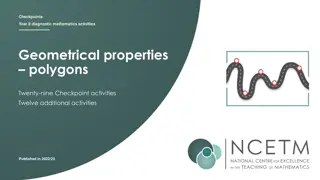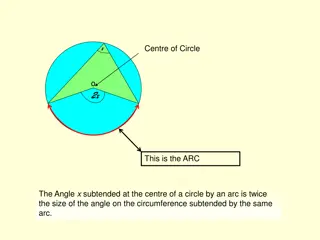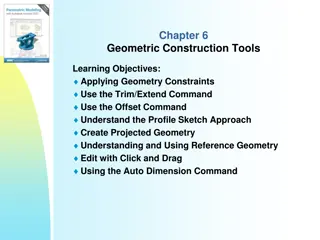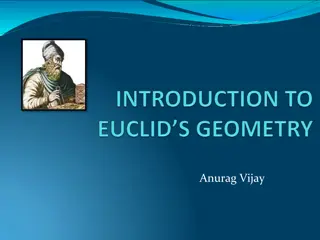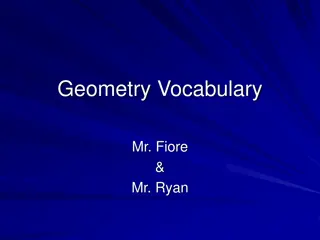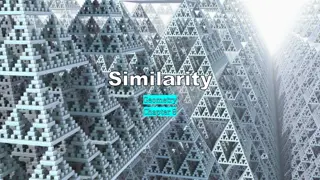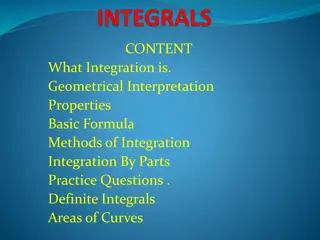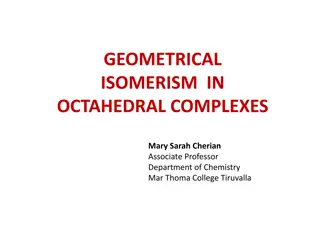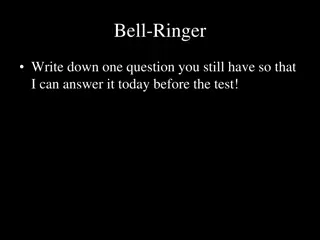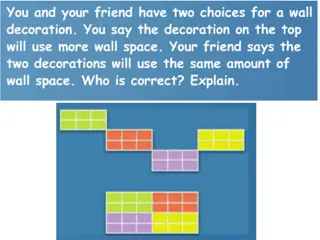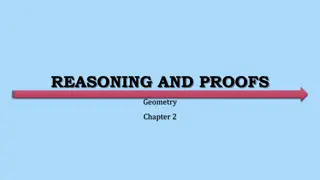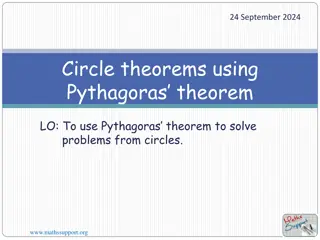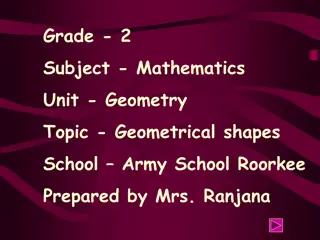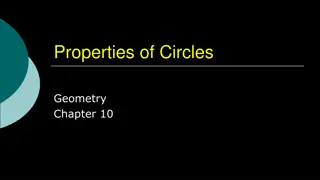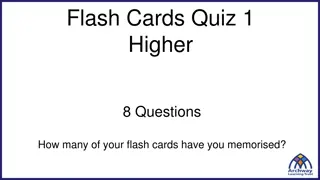Understanding Basic Geometrical Ideas in Geometry
Basic Geometrical Ideas in Geometry cover the fundamental concepts of points, lines, and planes. Points are described as having location but no size, lines are infinite sets of points, and collinearity is discussed. The importance of straightness in lines is assumed but not defined. Symbols and notations for points and lines are also explained.
Download Presentation

Please find below an Image/Link to download the presentation.
The content on the website is provided AS IS for your information and personal use only. It may not be sold, licensed, or shared on other websites without obtaining consent from the author. Download presentation by click this link. If you encounter any issues during the download, it is possible that the publisher has removed the file from their server.
E N D
Presentation Transcript
Grace Academy, Dimapur (IV) GEOMETRY Unit : Basic Geometrical Ideas Chapter 11 Pages: 154 to 166 Created by: R Chatterjee Maths Teacher, Grace Academy
Basic Geometrical Ideas In geometry, the terms point, line, and plane are described but not defined. Other concepts that are accepted intuitively, but never defined, include the straightness of a line, the flatness of a plane, the notion that a point on a line lies between two other points on the line, and the notion that a point lies in the interior or exterior of an angle. 2
Basic Geometrical Ideas The following are descriptions of some of the undefined terms. A point,which is represented by a dot, has location but not size; that is, a point has no dimensions. An uppercase italic letter is used to name a point. Figure 1.8 shows points A, B,and C. Figure 1.8 3
Basic Geometrical Ideas The second undefined geometric term is line.A line is an infinite set of points. Given any two points on a line, there is always a point that lies between them on that line. Lines have a quality of straightness that is not defined but assumed. Given several points on a line, these points form a straight path. Whereas a point has no dimensions, a line is one-dimensional; that is, the distance between any two points on a given line can be measured. 4
Basic Geometrical Ideas Line AB, represented symbolically by extends infinitely far in opposite directions, as suggested by the arrows on the line. A line may also be represented by a single lowercase letter. Figures 1.9(a) and (b) show the lines AB and m. When a lowercase letter is used to name a line, the line symbol is omitted; that is, and m can name the same line. Figure 1.9 5
Basic Geometrical Ideas Note the position of point X on in Figure 1.9(c). Figure 1.9 (c) When three points such as A, X,and B are on the same line, they are said to be collinear. In the order shown, which is symbolized A-X-B or B-X-A, point X is said to be between A and B. 6
Basic Geometrical Ideas When a drawing is not provided, the notation A-B-C means that these points are collinear, with B between A and C. When a drawing is provided, we assume that all points in the drawing that appear to be collinear are collinear, unless otherwise stated. Figure 1.9(d) shows that A, B,and C are collinear, in Figure 1.8, points A, B,and C are non-collinear. Figure 1.9 (d) 7 Figure 1.8
Basic Geometrical Ideas At this time, we informally introduce some terms that will be formally defined later. You have probably encountered the terms angle, triangle, and rectangle many times. An example of each is shown in Figure 1.10. Angle ABC (a) Triangle DEF (b) Rectangle WXYZ (c) Figure 1.10 8
Basic Geometrical Ideas Using symbols, we refer to Figures 1.10(a), (b), and (c) as ABC, DEF, and WXYZ,respectively. Some caution must be used in naming figures; although the angle in Figure 1.10(a) can be called CBA,it is incorrect to describe the angle as ACB because that order implies a path from point A to point C to point B . . . a different angle! Angle ABC (a) Figure 1.10 9
Basic Geometrical Ideas In ABC, the point B at which the sides meet is called the vertex of the angle. Because there is no confusion regarding the angle described, ABC is also known as B (using only the vertex) or as 1. The points D, E,and F at which the sides of DEF (also called DFE, EFD, etc.) meet are called the vertices (plural of vertex) of the triangle. Similarly, W, X, Y, and Z are the vertices of the rectangle; the vertices are named in an order that traces the rectangle. 10
Basic Geometrical Ideas A line segment is part of a line. It consists of two distinct points on the line and all points between them. (See Figure 1.11.) Using symbols, we indicate the line segment by note that is a set of points but is not a number. We use BC (omitting the segment symbol) to indicate the length of this line segment; thus, BC is a number. The sides of a triangle or rectangle are line segments. Figure 1.11 11
Example 1 Can the rectangle in Figure 1.10(c) be named a) XYZW? b) WYXZ? Figure 1.10 (c) Solution: a) Yes, because the points taken in this order trace the figure. b) No; for example, is not a side of the rectangle. 12
Measuring Line Segments The instrument used to measure a line segment is a scaled straightedge such as a ruler,a yardstick,or a meter stick. Line segment RS (in symbols) in Figure 1.12 measures 5 centimeters. Because we express the length of by RS (with no bar), we write RS = 5 cm. Figure 1.12 14
Measuring Line Segments To find the length of a line segment using a ruler: 1. Place the ruler so that 0 corresponds to one endpoint of the line segment. 2. Read the length of the line segment by reading the number at the remaining endpoint of the line segment. Because manufactured measuring devices such as the ruler, yardstick, and meter stick may lack perfection or be misread, there is a margin of error each time one is used. 15
Measuring Line Segments In Figure 1.12, for instance, RS may actually measure 5.02 cm (and that could be rounded from 5.023 cm, etc.). Measurements are approximate, not perfect. Figure 1.12 16
Measuring Line Segments In Example 2, a ruler (not drawn to scale) is shown in Figure 1.13. In the drawing, the distance between consecutive marks on the ruler corresponds to 1 inch. The measure of a line segment is known as linear measure. Figure 1.13 17
Example 2 In rectangle ABCD of Figure 1.13, the line segments and shown are the diagonals of the rectangle. How do the lengths of the diagonals compare? Figure 1.13 Solution: As shown on the ruler, AC = 10 . As intuition suggests, the lengths of the diagonals are the same, so it follows that BD = 10 . Note: In linear measure, 10 means 10 inches, and 10 means 10 feet. 18
Measuring Line Segments In Figure 1.14, point B lies between A and C on If AB = BC, then B is the midpoint of Figure 1.14 When AB = BC, the geometric figures to be congruent. Numerical lengths may be equal, but the actual line segments (geometric figures) are congruent. and are said The symbol for congruence is ; thus, if B is the midpoint of 19
Measuring Line Segments Please click below https://youtu.be/y-O_B-wWivQ 20
Measuring Angles An angle s measure depends not on the lengths of its sides but on the amount of opening between its sides. In Figure 1.16, the arrows on the angles sides suggest that the sides extend indefinitely. (a) (b) Figure 1.16 22
Measuring Angles The instrument shown in Figure 1.17 (and used in the measurement of angles) is a protractor. For example, you would express the measure of RST by writing m RST = 50 ; this statement is read, The measure of RST is 50 degrees. Figure 1.17 Measuring the angles in Figure 1.16 with a protractor, we find that m B = 55 and m 1 = 90 . 23
Measuring Angles If the degree symbol is missing, the measure is understood to be in degrees; thus m 1 = 90. In practice, the protractor shown will measure an angle that is greater than 0 but less than or equal to 180 . 24
Measuring Angles To find the degree measure of an angle using a protractor: 1. Place the notch of the protractor at the point where the sides of the angle meet (the vertex of the angle). See point S in Figure 1.18. Figure 1.18 25
Measuring Angles 2. Place the edge of the protractor along a side of the angle so that the scale reads 0. See point T in Figure 1.18 where we use 0 on the outer scale. 3. Using the same (outer) scale, read the angle size by reading the degree measure that corresponds to the second side of the angle. 26
Example 4 For Figure 1.18, find the measure of RST. Figure 1.18 Solution: Using the protractor, we find that the measure of angle RST is 31 . (In symbols, m RST = 31 or m RST = 31.) 27
Measuring Angles Some protractors show a full 360 ; such a protractor is used to measure an angle whose measure is between 0 and 360 . An angle whose measure is between 180 and 360 is known as a reflex angle. Just as measurement with a ruler is not perfect, neither is measurement with a protractor. 28
Measuring Angles The lines on a sheet of paper in a notebook are parallel. Informally, parallel lines lie on the same page and will not cross over each other even if they are extended indefinitely. We say that lines and m in Figure 1.19(a) are parallel; note here the use of a lowercase letter to name a line. Figure 1.19 (a) 29
Measuring Angles We say that line segments are parallel if they are parts of parallel lines; if is parallel to then is parallel to in Figure 1.19(b). Figure 1.19 (b) For A = {1, 2, 3} and B = {6, 8, 10}, there are no common elements; for this reason, we say that the intersection of A and B is the empty set (symbol is ). Just as A B = , the parallel lines in Figure 1.19(a) are characterized by m = . 30
Example 5 In Figure 1.20 the sides of angles ABC and DEF are parallel to and to Use a protractor to decide whether these angles have equal measures. Figure 1.20 Solution: The angles have equal measures. Both measure 44 . 31
Measuring Angles Two angles with equal measures are said to be congruent. In Figure 1.20, we see that ABC DEF. In Figure 1.21, ABC CBD. In Figure 1.21, angle ABD has been separated into smaller angles ABC and CBD; if the two smaller angles are congruent (have equal measures), then angle ABD has been bisected. Figure 1.21 In general, the word bisect means to separate a line segment (or an angle) into two parts of equal measure. 32
Measuring Angles Any angle having a 180 measure is called a straight angle,an angle whose sides are in opposite directions. See straight angle RST in Figure 1.22(a). When a straight angle is bisected, as shown in Figure 1.22(b), the two angles formed are right angles (each measures 90 ). Figure 1.22 33
Measuring Angles When two lines have a point in common, as in Figure 1.23, they are said to intersect. Figure 1.23 When two lines intersect and form congruent adjacent angles, they are said to be perpendicular. 34
Measuring Angles Please click below https://youtu.be/dw41PMWek6U 35
Constructions Another tool used in geometry is the compass.This instrument, shown in Figure 1.24, is used to draw circles and parts of circles known as arcs. The ancient Greeks insisted that only two tools (a compass and a straightedge) be used for geometric constructions, which were idealized drawings assuming perfection in the use of these tools. Figure 1.24 37
Constructions The compass was used to create perfect circles and for marking off segments of equal length. The straightedge could be used to draw a straight line through two designated points. A circle is the set of all points in a plane that are at a given distance from a particular point (known as the center of the circle). The part of a circle between any two of its points is known as an arc. 38
Constructions Any line segment joining the center to a point on the circle is a radius (plural: radii) of the circle. See Figure 1.25. Construction 1, which follows, is quite basic and depends only on using arcs of the same radius length to construct line segments of the same length. The arcs are created by using a compass. Figure 1.25 39
Constructions Construction 1 To construct a segment congruent to a given segment. Given: in Figure 1.26(a). Figure 1.26 (a) Construct: on line m so that (or CD = AB) 40
Constructions Construction: With your compass open to the length of place the stationary point of the compass at C and mark off a length equal to AB at point D, as shown in Figure 1.26(b). Then CD = AB. Figure 1.26 (b) 41
Constructions Construction 2 To construct the midpoint M of a given line segment AB. Given: in Figure 1.27(a). Construct: M on so that AM = MB Figure 1.27 (a) 42
Constructions Construction: Figure 1.27(a): Open your compass to a length greater than one-half of . Figure 1.27(b): Using A as the center of the arc, mark off an arc that extends both above and below segment AB. Figure 1.27 (b) 43
Constructions With B as the center and keeping the same length of radius, mark off an arc that extends above and below so that two points (C and D) are determined where the arcs cross. Figure 1.27(c): Now draw The point where crosses is the midpoint M. Figure 1.27 (c) 44
Example 7 In Figure 1.28, M is the midpoint of a) Find AM if AB = 15. b) Find AB if AM = 4.3. c) Find AB if AM = 2x + 1. Figure 1.28 Solution: a) AM is one-half of AB, so AM = b) AB is twice AM,so AB = 2(4.3) or AB = 8.6. c) AB is twice AM,so AB = 2(2x + 1) or AB = 4x + 2. 45


